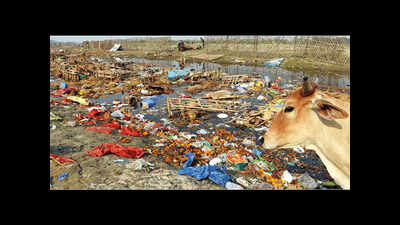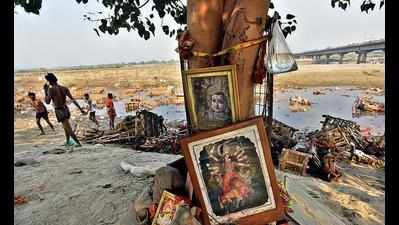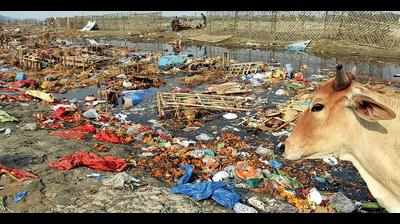- News
- City News
- delhi News
- After Friday fanfare, Yamuna resembles decaying waste field
Trending
This story is from October 21, 2018
After Friday fanfare, Yamuna resembles decaying waste field
NEW DELHI: At Qudsia Ghat on Saturday afternoon, Monu Kumar wades into the Yamuna, scrounging for anything useful in the ghostly debris in the water. The scene is eerily different from the chaos and noise of Friday when hundreds of bright-hued idols reached there amid much fanfare for immersion. As Kumar pokes around, he comes across an intact Durga idol. It is probably made of plaster of Paris because even 24 hours of submergence in water has not broken it down.
The shallow stretch looks like a typhoon devastated shore village.On the ghat are large mounds of decaying flowers and muddied adornments that had been pulled off the idols before immersion. Emerging out of the water is an ugly mess of straw, sticks and wood — the remnants of the idols. Among them, disconcertingly, a limb or a beauteous eye of Durga still refuses to yield to the water’s dissolving power.
“Only around 10% of the idols this year were made of plaster of Paris since rules no longer allow the use of PoP,” says Jeetu Parchar, a contractor appointed by the North Delhi Municipal Corporation to clear the ghat after the Durga Puja festivities. “Our bigger burden is retrieving the non-soluble decorations that embellished the idols. The guidelines are that these need to be removed before placing the idol in the river, but we come across all sorts of materials, even glass, in the water.”
Ideally, only the wooden scaffolding that held the idols erect should remain in the water. Corporation officials say these are reusable and are taken to the corporation stores. Everything else is collected and sent directly to a landfill. “The task of sifting through the waste is tedious. The workers scavenge whatever is useful or can be used, but most of the muck is piled up and sent to Ghazipur,” said Parchar.
As the contracted workers go about their work at Geeta Ghat, a group of children huddle together a few metres away. They are discussing their finds. As here, the immersion sites at Hathi Ghat, Qudsia, Kalindi Kunj, Shyam Ghat, Sur Ghat, Yamuna Ghat, DND Flyway and Mayur Vihar Extension Ghat provide some pickings for
Monu Kumar, employed to clean the river, admits he himself has not had much ‘luck’ in this department. “Most items of any value are taken by scavengers on the immersion day itself. Those who don’t get anything return at night, so you rarely find anything of worth the day after,” reasons the 25-year-old.
There was one more chance for ragpickers on Saturday, a day after Vijayadashmi, when some puja committees arrived to consign their idols to the river. “We avoided Friday because we knew it would be too crowded,” explains Ramesh Verma, who has come from Sultanpuri. “Usually, we immerse our idol a day later when the ghats are freer and we can go to the deeper parts of the river to ensure proper submergence. The portions demarcated at the ghats are always shallow, and it is an insult to Goddess Durga to leave her wallowing half out of water.”
The shallow stretch looks like a typhoon devastated shore village.On the ghat are large mounds of decaying flowers and muddied adornments that had been pulled off the idols before immersion. Emerging out of the water is an ugly mess of straw, sticks and wood — the remnants of the idols. Among them, disconcertingly, a limb or a beauteous eye of Durga still refuses to yield to the water’s dissolving power.
“Only around 10% of the idols this year were made of plaster of Paris since rules no longer allow the use of PoP,” says Jeetu Parchar, a contractor appointed by the North Delhi Municipal Corporation to clear the ghat after the Durga Puja festivities. “Our bigger burden is retrieving the non-soluble decorations that embellished the idols. The guidelines are that these need to be removed before placing the idol in the river, but we come across all sorts of materials, even glass, in the water.”
Ideally, only the wooden scaffolding that held the idols erect should remain in the water. Corporation officials say these are reusable and are taken to the corporation stores. Everything else is collected and sent directly to a landfill. “The task of sifting through the waste is tedious. The workers scavenge whatever is useful or can be used, but most of the muck is piled up and sent to Ghazipur,” said Parchar.
The workers are paid Rs 400 a day to clean the Yamuna, a task that lasts almost a week. “We lift out 50 to 60 idols each day, and it takes seven-eight men to take these out of the river,” said Ashu Kumar at Geeta Ghat. “The larger idols are almost impossible to drag out and we have to resort to cranes. We do end up getting a decent amount of money.”
As the contracted workers go about their work at Geeta Ghat, a group of children huddle together a few metres away. They are discussing their finds. As here, the immersion sites at Hathi Ghat, Qudsia, Kalindi Kunj, Shyam Ghat, Sur Ghat, Yamuna Ghat, DND Flyway and Mayur Vihar Extension Ghat provide some pickings for
scavengers in the form of baubles and trinkets to sell in the market. They also come across coins, sometimes even damp currency notes.
Monu Kumar, employed to clean the river, admits he himself has not had much ‘luck’ in this department. “Most items of any value are taken by scavengers on the immersion day itself. Those who don’t get anything return at night, so you rarely find anything of worth the day after,” reasons the 25-year-old.
There was one more chance for ragpickers on Saturday, a day after Vijayadashmi, when some puja committees arrived to consign their idols to the river. “We avoided Friday because we knew it would be too crowded,” explains Ramesh Verma, who has come from Sultanpuri. “Usually, we immerse our idol a day later when the ghats are freer and we can go to the deeper parts of the river to ensure proper submergence. The portions demarcated at the ghats are always shallow, and it is an insult to Goddess Durga to leave her wallowing half out of water.”
End of Article
FOLLOW US ON SOCIAL MEDIA













